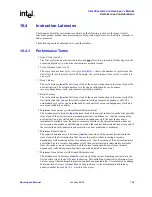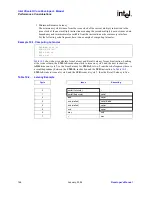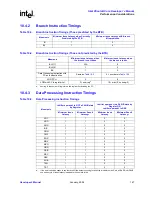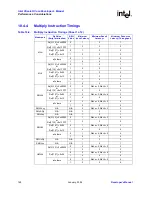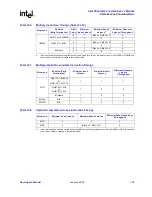
Developer’s Manual
January, 2004
177
Intel XScale® Core
Developer’s Manual
Optimization Guide
A.2.1.2.
The Intel XScale
®
Core Pipeline Organization
The Intel XScale
®
core single-issue superpipeline consists of a main execution pipeline, MAC
pipeline, and a memory access pipeline. These are shown in
Figure A-1
, with the main execution
pipeline shaded.
Table A-1
gives a brief description of each pipe-stage.
Figure A-1.
The Intel XScale
®
Core RISC Superpipeline
F1
F2
ID
RF
X1
X2
XWB
M1
M2
Mx
D1
D2
DWB
Main execution pipeline
MAC pipeline
Memory pipeline
Table A-1.
Pipelines and Pipe stages
Pipe / Pipestage
Description
Covered In
Main Execution Pipeline
Handles data processing instructions
Section A.2.3
IF1/IF2
Instruction Fetch
“
ID
Instruction Decode
“
RF
Register File / Operand Shifter
“
X1
ALU Execute
“
X2
State Execute
“
XWB
Write-back
“
Memory Pipeline
Handles load/store instructions
Section A.2.4
D1/D2
Data Cache Access
“
DWB
Data cache writeback
“
MAC Pipeline
Handles all multiply instructions
Section A.2.5
M1-M5
Multiplier stages
“
MWB (not shown)
MAC write-back - may occur during M2-M5
“



